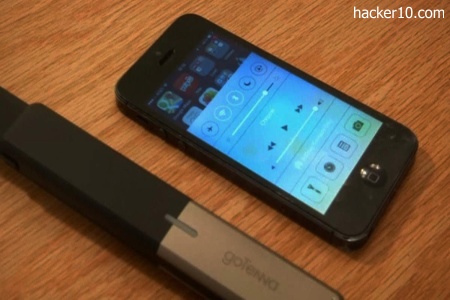Designed to be able to communicate without any Internet service provider, WiFi or mobile phone network, goTenna is a small autonomous hardware device that fits in your pocket and can be plugged into an iOS or Android smartphone to transmit low frequency 151-154 MHz radio waves to other goTenna users, pairing with them via Bluetooth LE (Low Energy). The device can not be used to make voice calls, but you can send text messages and share your location.
Possible utilities for goTenna are communications in disaster zones with destroyed infrastructure, sending an emergency message if you are lost in the middle of a mountain that has no mobile network coverage, and, private communications. This device should get around Internet mass surveillance frameworks set up to monitor Internet and mobile phone networks, unless an operative is within goTenna radiowave range with bulky wiretapping equipment, they better forget about intercepting or detecting goTenna data transmissions, not to mention that you do not have to pay for a subscription to use it.

With the device you get a custom goTenna app preloaded with offline maps to see your friend’s location without needing Google maps or an Internet connection, however, if you don’t remove the mobile phone SIM card, your GPS coordinates and that of your associates will be revealed to the network provider even when you are not placing a call.
Radio frequencies can be easily intercepted, to stop this goTenna secures your messages with 224-bit elliptic curve end to end encryption. There is no central server, messages are stored inside goTenna’s internal flash memory, it can hold 1000 messages. You communicate P2P with your friends, in group or individually, and it is possible to send self destructing messages to only one person, the message will be erased straight away after it has been read and not stored in the memory.
Communications range is an awesome 1 to 50 miles, depending on obstacles and geography, according to one of the founders, Daniela Perdomo, the maximum 50 miles range is only achievable if you are on top of a mountain, on the ground in an open space you get around 9 miles communications range and in the city, without line of sight and many obstacles around, you should get from 0.5 up to 1 mile range. Data transmission at 9600 bps is too slow for sending rich media like selfies, but enough for text messages.
Due to radio frequency regulations goTenna is not allowed to daisy chain a network in mesh, communications are point to point, but you can send a “shout” to all goTenna users in your vicinity or set up a private group chat.

Other similar self-ruling communication schemes that don’t need of a provider are existing mobile phone apps that communicate with other users P2P but their range is very low, bounded by Bluetooth, a couple of dozen meters. And of course you have the walkie talkie, it doesn’t need of an Internet service provider or satellite to operate but it does not encrypt radio waves like goTenna, unless it is a very high end device of the kind used by law enforcement and emergency services.
goTenna battery lasts up to 72 hours with low usage, the enclosure is weather and dust proof for you to take hiking inside your pocket or clipped to a rucksack band. I liked the small size, relatively long battery, it works autonomously without any state or corporation oversight of the data being transmitted, and the radio waves are encrypted with strong algorithms, the price is not so attractive. This device can work anywhere in the world, legally it needs a transmission license and right now it is only available in the US where they have FCC approval.



